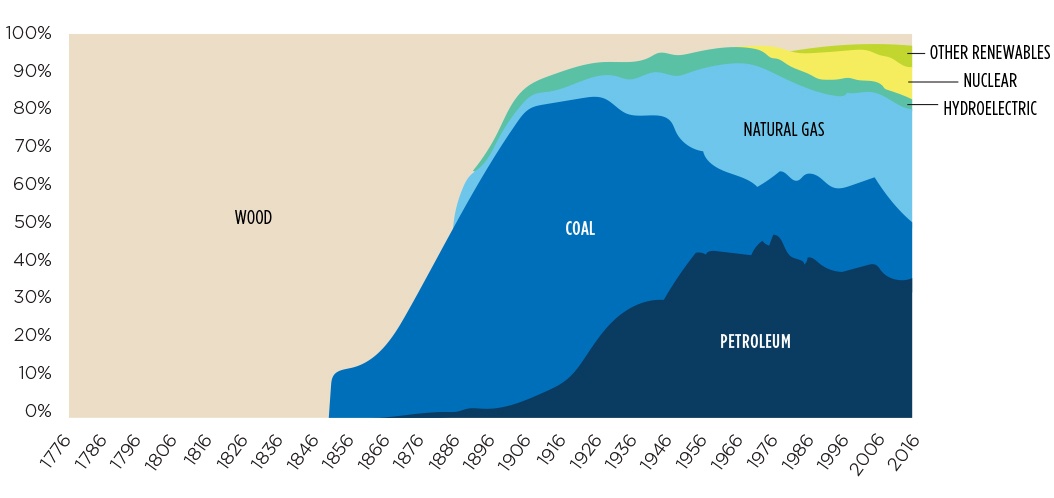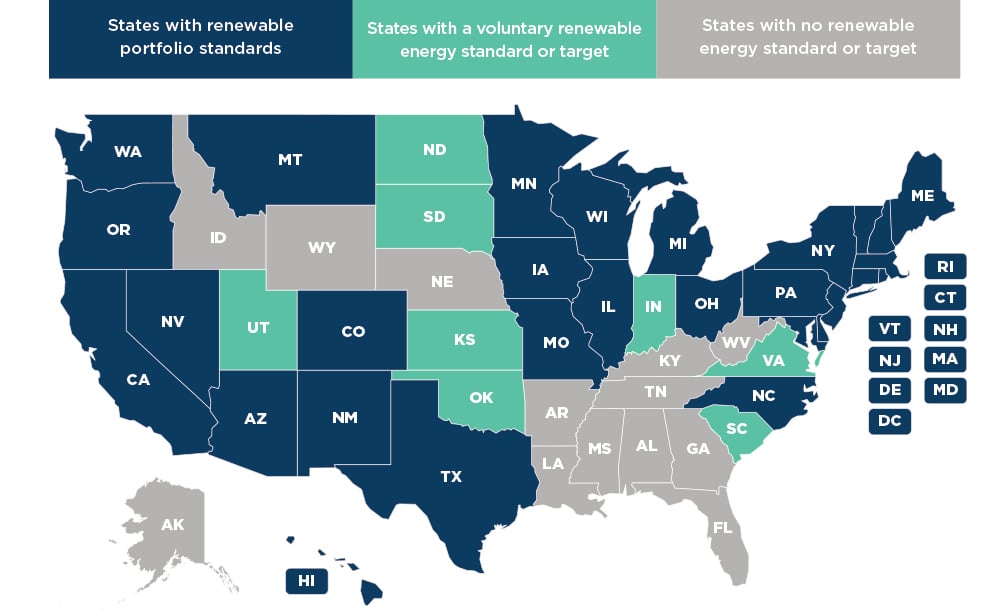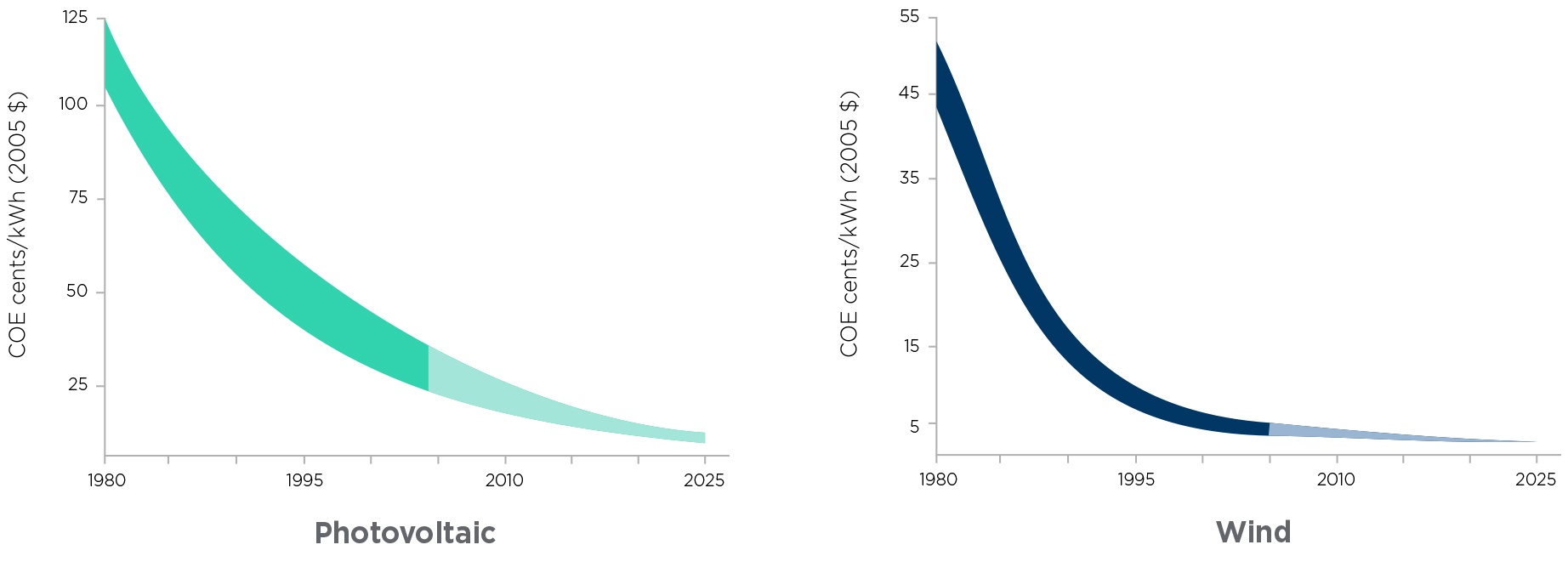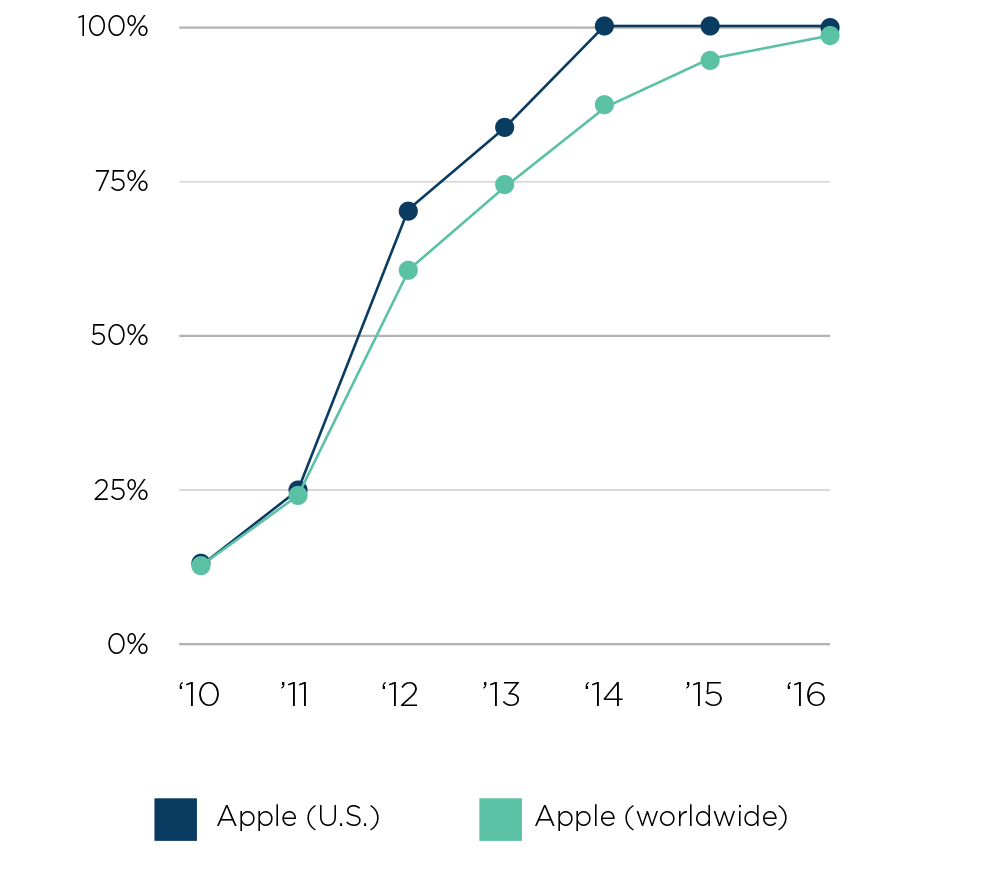According to the U.S. Department of Energy, “a clean energy revolution is taking place across America, underscored by the steady expansion of the U.S. renewable energy sector.” Renewable energy systems are being built across the country at an increasing rate. As reported by the American Wind Energy Association, GTM Research and the Solar Energy Industries Association, there are about 85 gigawatts of wind farms and more than 40 gigawatts of solar farms, including residential systems, operating in the U.S. While these numbers appear large, only 10 percent of the total energy consumption in 2016 was from renewable sources.
While electric utilities and renewables companies have historically taken the lead in providing renewable energy systems, corporations have now become a contributor to the generation of renewables. This is mainly due to sustainability opportunities through reducing their energy consumption and optimizing their operational costs. Corporations currently have several ways of incorporating renewable energy into operations: purchasing renewable energy certificates (RECs), building renewable energy systems outside facilities, or incorporating renewable resources into facilities.
ROLE OF RENEWABLE ENERGY IN THE U.S.
The U.S. has used a variety of energy sources to heat homes and businesses since its inception. Wood was the major supply of the country’s energy needs through the mid-1800s. In the following years, more consumers began using coal, petroleum and natural gas, and the U.S. relied less on wood as an energy source. Today, the use of renewable energy sources is increasing, particularly biofuels, solar and wind, which are slowly displacing natural gas and petroleum fuels. Figure 1 depicts the history of the use of energy sources to heat homes in the U.S. It is interesting to note that while renewables are a very small percent of the major sources, they appear to be increasing rapidly, similar to the rise in use of petroleum products.
It is safe to say that the U.S has enormous amounts of renewable resources — most produced from strong winds and sunny skies. The Great Lakes and coastal states are excellent locations for wind farms because of the near-constant wind that can be harnessed. The drier, more arid states like Arizona, California, southern Colorado, New Mexico, Nevada and West Texas are ideal for solar panels because of the high number of sunny days per year. Solar farms are less noticeable because they are built generally close to the ground and easily can be blocked by vegetation.

FIGURE 1: Share of U.S. energy consumption by major sources, 1776-2016. History of the use of energy sources to heat homes in the U.S. Source: U.S. Energy Information Administration, Monthly Energy Review, April 2017, preliminary data for 2016.
RENEWABLE ENERGY DRIVERS
The adoption or increase of renewable energy portfolio standards by individual states, as illustrated in Figure 2, is one of the drivers for incorporation of renewable energy in the U.S. As of Aug. 1, 2017, 29 states have standards that require utilities to sell a specified percentage of renewable electricity. Hawaii is leading the way with a goal of 100 percent renewable energy required by 2045.
But in September 2018, California modified its original goal of 50 percent renewable energy by 2030, calling for 100 percent zero-emissions sources, with renewable resources being augmented by nuclear power, a nonrenewable source with zero-carbon emissions, by 2045.
Eight states have instituted voluntary goals for renewable energy. Kansas and Utah have the highest goals of 20 percent by 2020 and 2025 respectively, while South Carolina has the lowest goal of 2 percent by 2021. As of Aug. 1, 2017, 13 states have not implemented any standards or goals for renewable energy.
Corporations can be an excellent asset to utilities within states. While corporations continue to find better ways to institute renewable energy into portfolios, utilities can offer services beneficial to both parties. Corporations can provide the capital needed to build new facilities and reap the benefits of increasing renewable energy usage, while utilities receive financing to help meet state-mandated renewable energy percentages. It’s an opportunity for both parties to meet their needs.

FIGURE 2: Breakdown of states and U.S. territories for renewable energy standards and goals. Source: National Conference of State Legislatures (2017)
WHY DOESN’T THE U.S. USE MORE RENEWABLE ENERGY?
So, if renewable energy is so plentiful in the U.S., why not use more of it? The cost of producing electricity from renewable energy is one of the main reasons. It is still cheaper to generate electricity from fossil fuels than natural renewable resources. In addition, favorable renewable resources are located in remote areas where installation of wind or solar farms might also require the installation of many miles of electrical transmission lines to connect the renewable energy to the electric grid. Likewise, wind farms in the rural areas of the eastern U.S. have fallen out of favor as local residents band together to fight against the installations, claiming noise pollution, damage to the ecosystem and obstruction of scenic views.
According to the U.S. Energy Information Administration, renewable sources also face the following challenges:
- Clouds reduce electricity from solar power plants.
- Days with low wind reduce electricity from wind farms.
- Droughts reduce the water available for hydropower.
- Renewable sources cannot typically be scaled up to match increased peak load on a given day.
- Solar plants cannot be operated at night.
Figure 3 identifies the historical and projected cost trends for solar and wind power between the years of 1980 and 2025. While the graphs show that further cost decreases are likely, the reduction in costs will be much slower than in previous years. This would suggest that the future cost of renewable energy will become more predictable, which is not the case for fossil fuels.

FIGURE 3: Declining costs of solar and wind energy. Source: National Renewable Energy Laboratories.
BENEFITS OF RENEWABLE ENERGY CERTIFICATES
Renewable energy certificates (RECs) provide a means for companies to participate in renewable energy by purchasing credits or certificates from renewable energy generators who have built wind farms or solar farms. Each REC represents a specific amount of electricity produced and delivered to the electric grid by renewable resources such as wind or solar. For example, each megawatt-hour (MWh) of electricity produced by renewable resources generates one REC. This REC can be kept or sold by the producer. When an REC is purchased, the purchaser is now the owner of that green power.
RECs are a part of every purchase of renewable energy and represent a credible way to purchase or sell renewable electricity. In addition, RECs can be uniquely numbered and tracked. When RECs are sold, there are systems that track the sale and record each transaction. Once an REC is purchased, it can no longer be sold or used by another company. The Environmental Protection Agency (EPA) recommends purchasing only RECs that are certified and verified. This process confirms that the REC purchased was from a quality renewable resource. Considered the currency of the renewable energy market, RECs allow companies to purchase cleaner sources of energy as well as reduce their carbon footprint when other avenues are not available.

FIGURE 4: Apple’s renewable energy use from 2010 to 2016. Source: Apple Environmental Responsibility Report (2017 Progress Report)
RECs provide companies the opportunity to participate in renewable energy when they are unable to produce it themselves. When RECs are purchased, companies are providing revenue that supports renewable energy projects and helps offset renewable energy generators’ operations and maintenance costs. Thus, REC purchases promote the growth of the green power marketplace. RECs also provide an opportunity for corporations to showcase participation in renewable energy even without installing any renewable energy systems at their facilities. Benefits of RECs to corporations include the opportunity to state they are offsetting their electricity usage with renewable resources with low or zero emissions.
OFF-SITE RENEWABLE ENERGY
But even if they wanted to, not all companies have the capability to install renewable energy systems. In large metropolitan areas where land is a premium, the use of that land for installation of renewable energy systems might not be a viable option. Other facilities cannot accommodate rooftop installations because of the structural integrity of their buildings.
Where a company’s existing facilities do not warrant the installation of solar panels or other renewable resources, the installation of off-site renewable energy systems like solar or wind farms are considered. These farms are connected to the electric grid, and the generated energy is sold to utilities or the grid.
Apple has committed to bring 4 gigawatts of renewable energy online by 2020. In 2017, Apple announced that it would build a 200-megawatt (MW) solar farm near Reno, Nevada. It also has a fully operational 130-MW farm in Monterey County, California, and another large facility in North Carolina. Some of these facilities are built next to Apple’s data centers to help meet the company’s goal of becoming 100 percent renewable.
Another example of off-site renewable energy systems is Amazon. In 2016, it announced plans to build its largest wind farm to date, in Texas. This 253-MW wind farm includes more than 100 turbines and produces enough energy annually to power almost 90,000 U.S. homes. Amazon also announced the construction of a 189-MW wind farm in Ohio and four other solar farms across the country with a capacity of 20 MW each.
ON-SITE RENEWABLE ENERGY
Another approach to renewable energy used by leading U.S. companies is to generate renewable energy at their facilities. Solar systems can be installed on the tops of warehouses or office complexes or on land around their facilities that is not being used. Some corporations build new facilities with the intent to incorporate renewable energy into them. This provides companies the direct opportunity to augment power consumption with green energy. Renewable energy generated from on-site systems can be considered an REC source, where the credits are used internally and not sold to others.
For instance, Amazon had a goal to install 770 MW of renewable energy at its facilities by the end of 2017. This was accomplished by adding solar panels to the tops of its warehouses. Amazon also set a goal to host solar energy systems at 50 fulfillment network buildings by 2020.
Another example of this approach is the Ford Motor Co., which teamed with DTE Energy to build a solar carport at its facility in Michigan to generate 1 MW of renewable energy each year. The carport provides 360 covered parking spaces and 30 charging stations for plug-in electric vehicles. It is the second-largest solar carport in the Midwest.
CORPORATE USE OF RENEWABLE ENERGY
The use of renewable energy by corporations to offset energy usage at facilities took off around 2010, and even earlier for some companies. Information on a few of the top U.S. companies was reviewed to determine each company’s approach to renewable energy.
Here are a few highlights:
- Walmart, with $500.3 billion in revenue last year, claims to be one of America’s leading on-site solar energy users. Approximately 26 percent of its energy consumption is provided by renewable energy. According to Walmart’s 2017 Sustainability Report, the company added 600 MW of renewable energy capacity worldwide since 2007. Walmart has more than 480 on-site and off-site projects in operation or under development in seven countries and 16 U.S. states. Walmart uses power purchase agreements — hiring another company to build and operate its renewable facilities — to facilitate its renewable energy sources.
- Apple, with $229.2 billion in revenue last year, says its power consumption in the U.S. is 100 percent from renewable energy sources and has been since 2014. Apple has approximately 1,000 MW of renewable energy systems installed in the U.S. and around the world, which equates to 96 percent of its power consumption. This effort began in 2010 when only 16 percent of its power consumption came from renewable resources. Apple’s progression in renewable energy is shown in Figure 4.
- Amazon, with $177.9 billion in revenue last year, installed 770 MW of renewable energy as of the end of 2017, with more facilities planned. Approximately 50 percent of Amazon’s power usage is provided by renewable energy. Amazon is installing solar arrays on the rooftops of its fulfillment network buildings and expects to have solar panels on 50 of its fulfillment centers by 2020.
- General Motors, with $157.3 billion in revenue last year, has a power purchase agreement with a Texas wind farm to begin the purchase of 50 MW of renewable energy, which is enough to power 16 of its facilities. While researching information for this paper, each company’s 2016 Sustainability Report was reviewed as a means of identifying relevant information regarding the company’s use of renewable energy. It was quickly determined that there is not a standard for sustainability reports. Companies focus on many different approaches to document their environmental goals in their sustainability reports.
Highlights include:
- Walmart has initiated Project Gigaton, which seeks to reduce 1 gigaton of emissions from manufacturing, materials and use of products by Walmart and all of its suppliers in addition to a goal of increasing its use of renewable energy.
- Ford focuses more on producing vehicles that are more efficient than on generating renewable energy for its facilities.
- Berkshire Hathaway owns utilities that have incorporated renewable energies into their portfolio rather than incorporating renewable energy into its own facilities to reduce energy consumption.
- United Health Group has focused on goals to reduce the amount of waste sent to landfills by 50 percent and has 1.7 million square feet of LEED-certified facilities. It also has energy improvement projects to upgrade exterior and interior lighting and improve building controls.
- General Electric’s renewable energy focus is on improving the wind and solar generation equipment that it sells rather than using renewable energy to replace energy usage by the company.
Disclaimer: The featured companies have sustainability goals that apply to their scope of services, and lack of renewable energy goals does not lessen focus on their own sustainability goals. While not all companies have renewable energy goals at this time, it is expected that in the near future more companies will recognize the need to incorporate goals into their operations as the cost for renewable energy continues to decrease.
The table on pages 7-9 in the PDF provides an overview of the renewable energy usage for some of the top U.S. companies. Additional information can be obtained on sustainability goals from each company’s website.
UTILITIES CAN BE RESOURCES FOR CORPORATIONS
Sustainability is a strong current trend with large corporations in the U.S. that have concerns about their impact to the world climate and are looking for immediate ways to incorporate sustainability into a portfolio. For many corporations, this means replacing power sources with renewable energy to fulfill immediate and short-term goals, increasing their renewable energy usage percentage significantly. For the first time, in 2015, major corporations and other nonutility customers purchased more than 50 percent — 52 percent, or 2,074 MW — of wind power capacity through power purchase agreements. It has been noted that the number of corporate power purchase agreements has doubled each year for the past five years. This trend is expected to continue, although at a slower pace.
More than half of states allow customers to use purchase power agreements to purchase electricity from entities other than their local utility.
One option for utilities to support the large corporations’ sustainability goals is through the use of green tariffs. As stated previously, many utilities are required to incorporate renewable energy into their portfolio by state mandates. As part of these mandates, green tariffs allow local utilities to sell renewable energy, whether purchased or generated, to large corporations at a higher rate than utilities can purchase or generate it and at a generally lower or equivalent rate than large corporations are currently paying. Both parties benefit from this opportunity: Utilities have long-term, local clients willing to purchase the renewable energy, and large corporations are provided a local source for renewable energy that might be more cost-efficient than constructing their own renewable energy or entering into power purchase agreements for renewable energy.
Google is a great example of the use of green tariffs. One of Google’s subsidiaries is the first company to purchase renewable energy from Duke Energy in North Carolina using its green tariff program. Google is purchasing 61 MW of renewable energy from a solar farm located near its data center.
In 2016, Dominion Virginia Power and an Amazon affiliate set up a green tariff system to allow the affiliate to sign power purchase agreements with local renewable energy generators and pay Dominion Virginia Power a price similar to the cost of power in the wholesale market. This appears to be an opportunity for both parties to successfully use renewable energy beneficially.
Generally, green tariffs require long-term agreements between the utility and the customer and might have a minimum consumption requirement. Green tariffs are usually set up in a manner that does not shift the energy costs from the large corporations to other ratepayers. The only limiting factor is the number of states that allow them. In 2018, 18 states allowed the use of green tariffs. This number is expected to grow as utilities recognize the opportunity to support the renewable energy need for large corporations.
CONCLUSION
With renewable energy providing only 10 percent of the total energy needs for the U.S., one might ask if it is possible to be 100 percent reliant on renewable energy. Further research should be completed to determine what the impact would be on the nation if wind and solar farms increased in usage from 10 percent to 50, 75 or even 100 percent. While there may be plenty of resources to support increasing the amount of energy generated from renewable resources, it’s unsure if wind and solar are the right type of resources to capture or if other types would be less invasive and provide better results. Research and development should continue to identify new ways to develop our renewable resources, as well as improve capabilities of wind and solar systems. Based on the changes seen in the past 40 years, hopefully the next 40 years will open new and better doors.
Though the total installed renewable energy systems by top U.S. companies on the Fortune 500 list represent only a fraction of the total renewable energy generated, some of these companies have set significant goals for renewable energy to offset energy consumption from non-renewable resources within the next five to 15 years, as shown in Figure 5. Some have even already sourced 100 percent of energy needs as renewable energy. As the cost of installation of renewable energy systems continues to decrease, it can be expected that more companies will look to renewable energy as a safe and viable alternative to current practices.